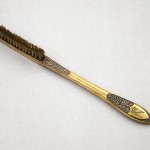One of our Laundry Revolutionaries wanted to know how to get rid of those stubborn rings which form inside shirt collars. So, we thought we should share our tips!
For all of these tips, an old toothbrush will really help you out – if you’ve got one that’s been sitting around for a while that you might be happy to replace, they’re very handy for really getting your home-made stain removers deep into the fabric!

OK, not that old
There are a good few ways to get rid of these pesky stains, but it does depend whether your shirts are white (ooh, classy) or coloured (stylin’!).
For white shirts, make your own stain remover by mixing 1 part white vinegar with 1 part water. Let your shirt sit in the solution for a few hours or overnight, then pop in the washing machine as normal.

When life gives you lemons, make home-made stain remover!
If you don’t have any white vinegar, try direcly applying lemon juice, which can rival heavy duty cleaners for cleaning power. Or, if you need a quicker fix, get a little of your dish washing detergent and mix it with water to make a paste. Apply that to the stained area and let it sit for half an hour or so before laundering in the machine.
(Gross tip – the rings around the collar are formed by the natural oils from your neck, so as well as dish washing detergent, you can use any cleaning agent labelled as a “degreaser”.)
CAREFUL THOUGH! The above methods can all bleach dyed clothing, and for your colours, you’ll need something a bit more gentle.

Don’t forget to take the shampoo out of the shower first…
Firstly, try a bit of shampoo – it is designed to remove body oils, after all! Doesn’t matter what kind you use, so this is your chance to get rid of the awful bubblegum shampoo you accidentally bought, or that caustic hotel stuff that slipped into your washbag. Use an old toothbrush to rub a little shampoo directly into the stain, let it sit for 15-30 minutes, then wash as normal.
Alternatively, if you have some lanolin-based handwash, apply some to the stains on your shirt (fine with whites or colours), let it sit for 15 minutes, then wash. This method might take a couple of goes!
Of course, if none of these work, or if you just don’t have the time, send your shirts in to LaundryRepublic and our experienced team will be happy to take care of those nasty stains for you!
Flickr images credit: Napoleon’s toothbrush, c 1795 by Science Museum London; Lemons by Penelope Waits; Tears in rain by FailedImitator





